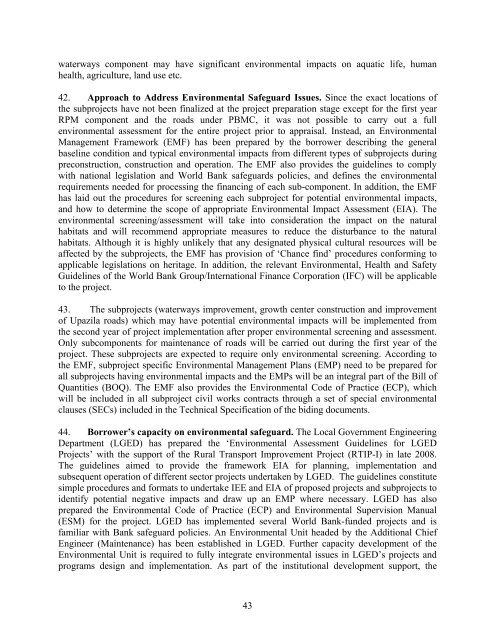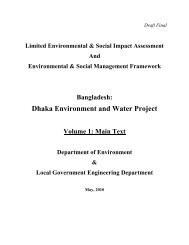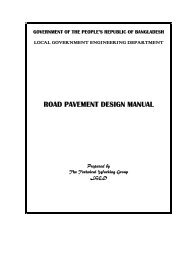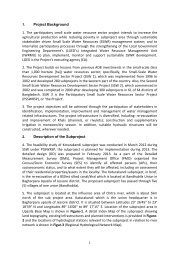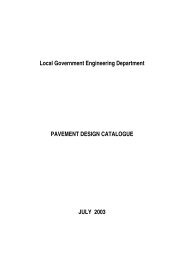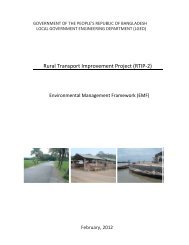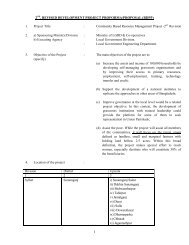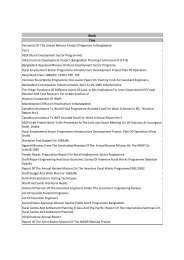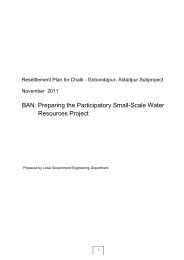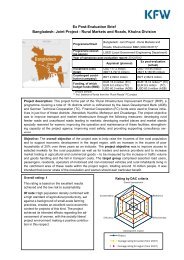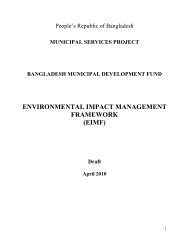PAD - LGED
PAD - LGED
PAD - LGED
You also want an ePaper? Increase the reach of your titles
YUMPU automatically turns print PDFs into web optimized ePapers that Google loves.
waterways component may have significant environmental impacts on aquatic life, human<br />
health, agriculture, land use etc.<br />
42. Approach to Address Environmental Safeguard Issues. Since the exact locations of<br />
the subprojects have not been finalized at the project preparation stage except for the first year<br />
RPM component and the roads under PBMC, it was not possible to carry out a full<br />
environmental assessment for the entire project prior to appraisal. Instead, an Environmental<br />
Management Framework (EMF) has been prepared by the borrower describing the general<br />
baseline condition and typical environmental impacts from different types of subprojects during<br />
preconstruction, construction and operation. The EMF also provides the guidelines to comply<br />
with national legislation and World Bank safeguards policies, and defines the environmental<br />
requirements needed for processing the financing of each sub-component. In addition, the EMF<br />
has laid out the procedures for screening each subproject for potential environmental impacts,<br />
and how to determine the scope of appropriate Environmental Impact Assessment (EIA). The<br />
environmental screening/assessment will take into consideration the impact on the natural<br />
habitats and will recommend appropriate measures to reduce the disturbance to the natural<br />
habitats. Although it is highly unlikely that any designated physical cultural resources will be<br />
affected by the subprojects, the EMF has provision of ‘Chance find’ procedures conforming to<br />
applicable legislations on heritage. In addition, the relevant Environmental, Health and Safety<br />
Guidelines of the World Bank Group/International Finance Corporation (IFC) will be applicable<br />
to the project.<br />
43. The subprojects (waterways improvement, growth center construction and improvement<br />
of Upazila roads) which may have potential environmental impacts will be implemented from<br />
the second year of project implementation after proper environmental screening and assessment.<br />
Only subcomponents for maintenance of roads will be carried out during the first year of the<br />
project. These subprojects are expected to require only environmental screening. According to<br />
the EMF, subproject specific Environmental Management Plans (EMP) need to be prepared for<br />
all subprojects having environmental impacts and the EMPs will be an integral part of the Bill of<br />
Quantities (BOQ). The EMF also provides the Environmental Code of Practice (ECP), which<br />
will be included in all subproject civil works contracts through a set of special environmental<br />
clauses (SECs) included in the Technical Specification of the biding documents.<br />
44. Borrower’s capacity on environmental safeguard. The Local Government Engineering<br />
Department (<strong>LGED</strong>) has prepared the ‘Environmental Assessment Guidelines for <strong>LGED</strong><br />
Projects’ with the support of the Rural Transport Improvement Project (RTIP-I) in late 2008.<br />
The guidelines aimed to provide the framework EIA for planning, implementation and<br />
subsequent operation of different sector projects undertaken by <strong>LGED</strong>. The guidelines constitute<br />
simple procedures and formats to undertake IEE and EIA of proposed projects and subprojects to<br />
identify potential negative impacts and draw up an EMP where necessary. <strong>LGED</strong> has also<br />
prepared the Environmental Code of Practice (ECP) and Environmental Supervision Manual<br />
(ESM) for the project. <strong>LGED</strong> has implemented several World Bank-funded projects and is<br />
familiar with Bank safeguard policies. An Environmental Unit headed by the Additional Chief<br />
Engineer (Maintenance) has been established in <strong>LGED</strong>. Further capacity development of the<br />
Environmental Unit is required to fully integrate environmental issues in <strong>LGED</strong>’s projects and<br />
programs design and implementation. As part of the institutional development support, the<br />
43


